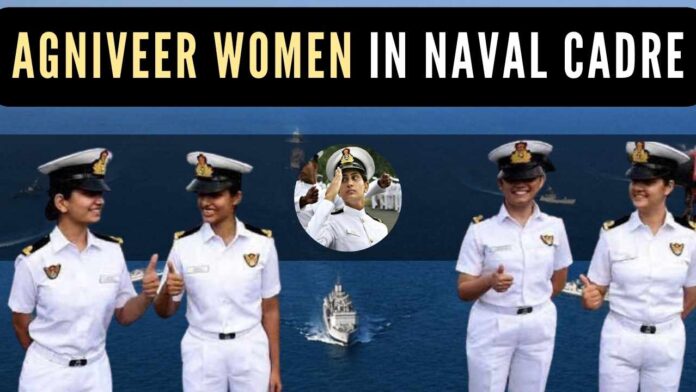
Women in Indian Navy combat mode
Agniveer Women trainees, of Agnipath, as a major transformation ahead of the arrival of the first batch the INS Chilka, the navy’s basic training establishment in Odisha, is undergoing a major shift to give women empowerment in Naval exercises.
Indian Navy is all set to introduce by September first week. The first batch of Agniveer Women officers into combat mode.
The next step is to ensure that Visakhapatnam, Chennai, and Kochi Naval bases are to have women combat officers in a gradual introduction of women’s power in the Indian Navy by 2024.
In Odhisa, the sprawling lakeside campus is getting a raft of facilities that will make life easier for the 600 women who are on the threshold of a naval career, a top admiral said.
“While women trainees will have separate residential and dining areas, they will carry out all academic and training activities alongside their male counterparts,” he said. The navy’s first Agniveeers are expected to begin their training at INS Chilka on November 21.
The training establishment has 50 officers in different roles, including 13 women officers.
Almost a million applicants, including more than 82,000 women, have registered for recruitment into the navy under the Agnipath model for short-term induction of soldiers into the three services, and the selection process is underway. Those recruited under the new model will be called Agniveers.
These applicants are competing for 3,000 jobs in the navy, with women expected to account for 20% (600) of the first intake under the new recruitment model.
Some of these women, who will be inducted as Agniveers early next year, are likely to be deployed on India’s first indigenous aircraft carrier Vikrant, the largest warship to be built in the country and likely to be commissioned on September 1 by Prime Minister Narendra Modi in Kochi.
From earmarking two new accommodation blocks exclusively for them to installing sanitary pad vending and disposal machines, creating a separate dining area, to hiring women staff, the training establishment is becoming women-friendly, said Vice Admiral M A Hampiholi, who heads the Southern Naval Command and is monitoring the changes underway at the training facility.
The Kochi-headquartered Southern Naval Command is responsible for the whole gamut of training for the navy.
“Specific changes have been made to cater to different needs of women trainees, including privacy. We took inputs from serving women officers to understand those needs before initiating the changes at INS Chilka,” he said. The navy began inducting women as officers three decades ago, but this is the first time they are being recruited as sailors.
Other changes at INS Chilka include setting up more toilets for women trainees, installation of security cameras, and hiring women as matrons, swimming instructors, and safai karamcharis, said a senior navy officer posted at INS Chilka.
“The women officers will mentor the women trainees, take care of their needs and ensure a smooth transition,” said Hampiholi. The women sailors will be inducted into all 29 branches and trades of the navy and will be given warship assignments too.
Inducting women as sailors is a welcome and progressive step, and the navy has shown remarkable foresight by planning the changes at INS Chilka, said Commander Gauri Mishra (retd). “It has worked everything out in minute detail to make the training facility women-friendly. Kudos to the navy,” said Mishra, who is a skydiver and has served as a flag lieutenant to a navy chief.
INS Chilka sent teams to training establishments of the Corps of Military Police, the Border Security Force, and the Central Industrial Security Force (all of them train women), and the inputs gathered were distilled before finalizing the training regimen and other changes, said Hampiholi.
“There will be no difference in the training curriculum for men and women. However, the mandatory physical standards to be achieved by them will be different in line with the practices followed by training establishments worldwide,” he said.
The navy is the only service recruiting women in the personnel below officer rank (PBOR) cadre in the first phase of Agnipath.
The armed forces will recruit 46,000 Agniveers this year including 40,000 in the army and 3,000 in the Indian Air Force.
India on June 14 announced the Agnipath scheme replacing the legacy system of recruitment to lower the age profile of the armed forces, ensure a fitter military and create a technically skilled warfighting force capable of meeting future challenges. It sparked widespread protests and forced a concerted outreach by the government to scotch apprehensions about the scheme.
The scheme seeks to recruit soldiers for only four years, with a provision to retain 25% of them in the regular cadre for 15 years after another round of screening.
Note:
1. Text in Blue points to additional data on the topic.
2. The views expressed here are those of the author and do not necessarily represent or reflect the views of PGurus.
PGurus is now on Telegram. Click here to join our channel and stay updated with all the latest news and views
For all the latest updates, download PGurus App.
- Modi-Yogi duo focus on Kashi Tamil Sangamam - December 20, 2023
- Modi magic at its peak to decimate Congress - December 3, 2023
- Why in the 2024 Lok Sabha polls six South Indian states do not matter? - November 16, 2023










